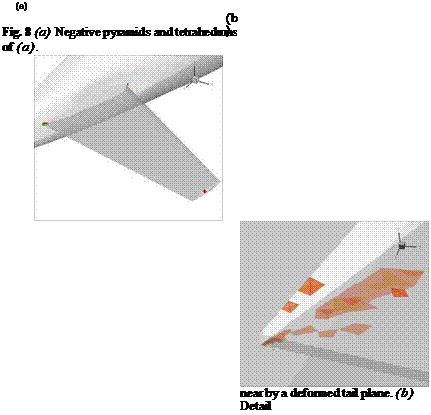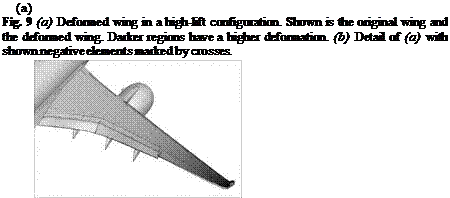Mesh Manipulation
2.3.1 Repairing of Meshes
Negative elements occur many times by applying a deformation on the mesh, e. g. for CFD/CSM coupling. The appearance of negative cells permits a CFD computation on those grids. To avoid a new meshing of the deformed geometry and to measure effects below the uncertainties of mesh effects the negative cells have to be repaired. Here the repairing of negative elements was successfully demonstrated on two configurations. An isotropic metric was chosen to calculate the quality measure.
The first test case was a clean wing/body configuration with horizontal tail planes. To trim the configuration the horizontal tail plane was deformed. Due to deformation of the tail plane 83 elements with a negative volume occur (figure 8). These inverted elements are tetrahedrons and pyramids. By applying the mesh modification all negative elements vanish.
The second test case was a commercial aircraft including wing, body, nacelle, pylon, vertical tail plane and flap track fairings in a high-lift configuration (figure 9a). Due to the applied deformation, 26 tetrahedrons have a negative volume. These elements are located in the slot between the flap inboards and the wing (figure 9b). Again, by applying the implemented mesh modification all negative tetrahedrons are inverted to valid elements with a positive volume.
In many cases the generation of negative elements can also be prevented by applying the mesh modification on elements with a low quality before the mesh is deformed. For example in the previous case of trimming the horizontal tail plane, negative elements were prevented if the mesh was improved before the deformation step is performed.
|
|
|
Fig. 7 (a) Lift Cl as function of the angle of attack a for the TC-217 model. (b) Polar for Cl and Cd of the TC-217 model. + marks the results computed on the base mesh. о and □ denote the results of the meshes adapted with the adjoint lift sensor for a1 and a2. Д and x show the results for the adapted grids with respect to the drag. The solid line shows the experimental results. |
 |
 |
 |
Another application of the mesh modification is the improvement of the quality of the unstructured part of the mesh when the computation on the mesh diverges. In figure 10(a) an example is shown where many tetrahedrons have a bad shape. By applying the mesh modifications the number of badly shaped elements decreases significantly (figure 10b). The number of tetraherons with a dihedral angle less than one degree decreases from N^<1o = 6840 to N^<1o = 29. The number of tetraherons with a dihedral angle less than five degree decreases fromN^<1o = 34598 to N^<1o = 252. Note that after the improvement of the mesh a converged CFD solution could be achieved.
 |
 |
Fig. 10 Mesh with many badly shaped tetrahedral elements before (a) and after (b) the mesh modification. In both figures elements with a dihedral angle less than one degree are shown.















